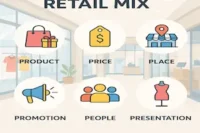What are Primary, Secondary, and Tertiary Sales? Tips to Improve
Published: 08 Jun 2025
Sales are the soul of a successful business. Depending on what type of businessman you are, you regularly face different types of sales, and they are commonly known as
- Primary sales
- Secondary Sales and
- Tertiary Sales
All of these levels of sale are part of the typical supply chain and show how a product reaches the end customer. Each stage plays a key role in moving goods from the manufacturer to the final buyer.
Here’s a deep guide about what the primary, secondary, and tertiary sales are.
What are Primary sales?
Guys as we know, the first step in sales is always manufacturing a valuable product and after that it is sold to other businesses or customers. When we talk about the movement of goods from manufacturers to distributors, that’s where primary sales take place.
Simply put, when a manufacturer sells his goods to the distributor, it is called a primary sale. This is the first sale in the supply chain. It helps move products out of the factory and into the market. The goal here is to get the product ready for wider distribution. Primary sales can be affected by the popularity of the brand and product demand.
Here are a few key points to remember:
- Primary sales happen between manufacturers and distributors.
- It helps clear inventory from the factory.
- Primary sales are used to track company sales targets.
- They can be influenced by brand popularity and product demand.
- These sales are often pushed at the end of the month or quarter to meet targets.
- It’s a business-to-business (B2B) transaction.
The popular example includes when Coca Cola ships its energy drinks to different countries with the help of distributors. It is doing a primary sale. The distributors will then sell these drinks to retailers or wholesalers.
That’s said!!
What Are Secondary Sales?
Secondary sales happen when a distributor sells products to retailers, wholesalers, or dealers. This is the second step in the sales process, after primary sales, where the manufacturer sells to the distributor.
Secondary sales reflect actual product movement in the market and help measure consumer demand. They also help companies track stock levels at retail outlets, plan inventory, and assess how well a product is selling at the ground level.
However, secondary sales can be affected by many factors, especially consumer demand, brand awareness, and competitor pricing strategies.
If your brand lacks awareness, you’ll need to run product promotions using influencers, social media campaigns, or celebrity endorsements. These marketing efforts can boost visibility, attract buyers, and improve your secondary sales performance.
What Are Tertiary Sales?
Now guys we’ve the last topic to discuss and that’s tertiary sale or we can also say it B2C business. It is the final step of the sales process, where the product reaches the end consumer.
Tertiary sales happen when a customer buys the product from a retail shop, online store, or local dealer. This stage reflects the actual demand from real users and shows how successful your product is in the market.
These sales are most important because they bring in real revenue and give direct feedback from customers. If tertiary sales are low, it means customers are not buying goods, which may be due to many reasons, especially if your brand is new to the market and customers don’t have enough knowledge about it. Higher pricing strategies than your competitors could also be the key reason.
To improve tertiary sales, you should focus on building brand awareness, running promotional offers, giving discounts, and using social media marketing. You can also share customer reviews, collaborate with influencers, or offer free samples to build trust and attract new buyers.
How can you increase Primary, Secondary, and Tertiary sales?
Sales are the backbone of a successful business. They set the future of a company by increasing its growth rate, building brand trust and keeping the supply chain active at every level.
Here’s a step-by-step guide on how to increase primary, secondary, and tertiary sales.
Optimizing Primary Sales.
- Try to make strong connections with your distributors. The more you engage with them, the more the trust builds which ultimately boosts your sales.
- Set clear sales targets, track performance and then manage your inventory accordingly. Make sure you never go out of stock. This gives your distributors more confidence to push your product further.
- Offer attractive trade schemes, discounts, or bulk order benefits to motivate larger purchases.
- Educate and train your distributors with everything about your product. the product’s features, uses, and selling points. This helps them market it better.
- Educate and train your distributors on everything about your product. Help them understand its features, benefits, target customers, and how it stands out from competitors. The more they know, the better they can sell and promote it in the market.
Optimizing Secondary Sales
- Build strong relationships with retailers. Stay in touch, listen to their challenges, and support them regularly.
- Provide marketing support. Give retailers posters, banners, and digital content to promote your product better.
- Run retailer-level schemes. Offer small rewards, cashback, or free units for hitting sales targets.
- Ensure fast and smooth delivery. Retailers need timely restocks to avoid missing sales. Make sure your supply chain works well.
- Collect and use retailer feedback. Ask what’s selling and what’s not—then adjust your approach to match demand.
- Train retailer staff. Help them understand how to pitch the product to customers in simple words.
- Track secondary sales performance. Set targets and measure how much stock is moving from distributors to retailers. This helps you spot sales trends, fix gaps, and plan smarter strategies to boost retail-level growth.
Optimizing Tertiary Sales.
- The first step to improve tertiary sales is to understand your end customers by knowing who they are, what they want, and what problems your product solves for them. This helps you position your product in a way that feels personal and useful to them.
- Make your product stand out in stores. Use eye-catching packaging and place your product where it’s easy to see. Good visibility leads to better chances of being picked
- Run consumer-level promotions. Offer discounts, combo deals, or small giveaways. These encourage first-time buyers and help boost repeat sales.
- Use social media and digital ads. Promote your product where your customers spend time—like Instagram, Facebook, or YouTube. This creates brand awareness and builds interest.
- Encourage customer feedback. Ask buyers what they think about your product. Good or bad, feedback helps you improve and build trust.
- Create word-of-mouth buzz. A happy customer can bring in more customers. Encourage reviews, referrals, and testimonials.
- Train in-store staff. Teach shopkeepers or floor staff how to introduce your product and highlight its benefits. A confident recommendation can lead to more sales.
- Study customer buying patterns. Track what sells fast, when it sells, and who’s buying. Use this data to make better marketing and product decisions.
Hey My Champs
So today we have deeply understood primary, secondary, and tertiary sales and, most importantly, how to improve them.
These three levels of sales are the pillars of a strong supply chain. Whether you’re a manufacturer, distributor, or retailer, knowing how to boost each type of sale can take your business to the next level.
Now it’s your turn—start applying these simple tips in your sales strategy and see the difference for yourself.
Keep learning, keep growing. You’ve got this!

- Be Respectful
- Stay Relevant
- Stay Positive
- True Feedback
- Encourage Discussion
- Avoid Spamming
- No Fake News
- Don't Copy-Paste
- No Personal Attacks



- Be Respectful
- Stay Relevant
- Stay Positive
- True Feedback
- Encourage Discussion
- Avoid Spamming
- No Fake News
- Don't Copy-Paste
- No Personal Attacks





